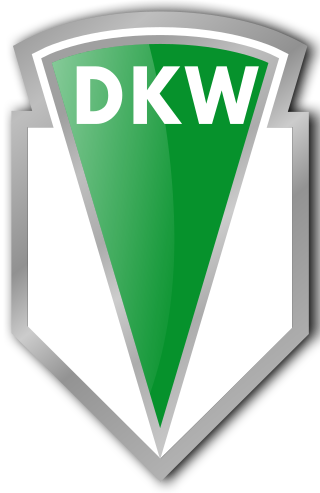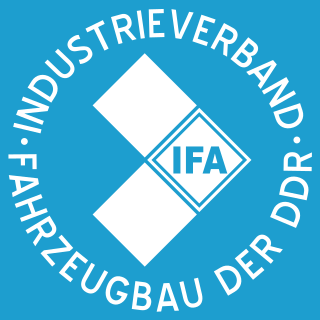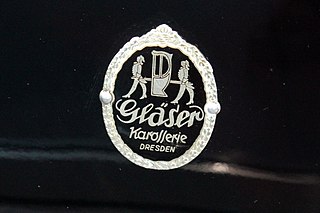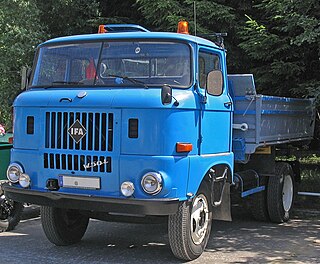
DKW was a German car- and motorcycle-marque. DKW was one of the four companies that formed Auto Union in 1932 and thus became an ancestor of the modern-day Audi company.
Trabant is a series of small cars produced from 1957 until 1991 by former East German car manufacturer VEB Sachsenring Automobilwerke Zwickau. Four models were made: the Trabant 500, Trabant 600, Trabant 601, and the Trabant 1.1. The first model, the 500, was a modern car when it was introduced. It featured a duroplast body on a one-piece steel chassis, front-wheel drive, a transverse two-stroke engine, and independent suspension. Because this 1950s design remained largely unchanged until the introduction of the last model, the Trabant 1.1 in 1990, the Trabant became symbolic of the former East Germany's stagnant economy and the collapse of the Eastern Bloc in general. Called "a spark plug with a roof", 3,096,999 Trabants were produced. Older models have been sought by collectors in the United States due to their low cost and fewer restrictions on the importation of antique cars. The Trabant also gained a following among car tuning and rally racing enthusiasts.

Zwickau (German pronunciation: [ˈtsvɪkaʊ]; is, with around 87,500 inhabitants, the fourth-largest city of Saxony after Leipzig, Dresden and Chemnitz and it is the seat of the Zwickau District. The West Saxon city is situated in the valley of the Zwickau Mulde, and lies in a string of cities sitting in the densely populated foreland of the Elster and Ore Mountains stretching from Plauen in the southwest via Zwickau, Chemnitz and Freiberg to Dresden in the northeast. From 1834 until 1952, Zwickau was the seat of the government of the south-western region of Saxony.

Auto Union AG, was an amalgamation of four German automobile manufacturers, founded in 1932 and established in 1936 in Chemnitz, Saxony. It is the immediate predecessor of Audi as it is known today.

Duroplast is a composite thermosetting resin plastic developed by engineer Wolfgang Barthel in the German Democratic Republic. Its production method places it in a similar family as Formica and Bakelite. It is also reinforced with fibers making it a fiber-reinforced plastic similar to fiberglass.

Horch was a car brand manufacturer, founded in Germany by August Horch & Cie at the beginning of the 20th century.

Industrieverband Fahrzeugbau, usually abbreviated as IFA, was a conglomerate and a union of companies for vehicle construction in the former East Germany.

The AWZ P70 "Zwickau" is a small family car which was produced in East Germany by VEB Automobilwerke Zwickau (AWZ) between 1955 and 1959.

The Horch P240 or Sachsenring P240 was a luxury car built by the VEB Kraftfahrzeugwerk Horch Zwickau in East Germany between 1955 and 1959. The early preproduction models can be identified by the grill, which is divided in two and has vertical bars.

The DKW F8 is a compact front-wheel drive two-stroke engined saloon, introduced in 1939. The F8 was slightly shorter than its predecessor despite having a marginally increased wheelbase. The base model, known as the Reichsklasse, was manufactured only till 1940 but the Meisterklasse sedan continued in production until 1942. In addition to the saloons, cabriolet versions were offered.

The Trabant 601 was a Trabant model produced by VEB Sachsenring in Zwickau, Saxony. It was the third generation of the model, built for the longest production time, from 1964 to 1990. As a result, it is the best-known Trabant model and often referred to simply as "the Trabant" or "the Trabi". During this long production run, 2,818,547 Trabant 601s were produced overall and it was the most common vehicle in former East Germany.

Industriewerke Ludwigsfelde is an automotive factory in Ludwigsfelde in Brandenburg, just south of Berlin in Germany. The factory is part of Daimler AG and since 1991 it has made Mercedes-Benz vans. It is also the producer of the Multicar line of automobiles.

The August Horch Museum Zwickau is an automobile museum in Zwickau, Saxony, Germany. Opened in 2004, it covers the history of automobile construction in Zwickau, the home of Horch and Audi prior to World War II, and Trabant during the Cold War-era German Democratic Republic.

Gläser-Karosserie GmbH was a German coachbuilder, based in Dresden, and known in particular as a producer of bespoke cabriolet car bodies. The enterprise was founded in 1864 and lasted, by some criteria, till 1952.

The IFA W 50 is a medium-duty truck built by the East German IFA conglomerate at their Ludwigsfelde plant from 1965 until 1990. A total of about 572,000 were built in Ludwigsfelde, with an unknown additional number of special-use vehicles assembled at other plants. It was meant to be succeeded by the IFA L 60 but outlived it by several months. IFA ended all truck production on 17 December 1990, following the reunification of Germany.

The Trabant 1.1 is the fourth and final series production model of the East German Trabant series, made by VEB Sachsenring Automobilwerke Zwickau. Unlike its predecessors, which have a two-stroke engine, the Trabant 1.1 has a four-stroke Otto engine. In total, 39,474 units of the Trabant 1.1 were made from May 1990 to 30 April 1991, which makes it the rarest Trabant model.

The Trabant P 50, also known as the Trabant 500, is the first series production model of the East German Trabant series, made by VEB Sachsenring Automobilwerke Zwickau. It was produced from 1957 until 1962; in total, 131,495 units were built. In 1962, VEB Sachsenring switched production from the P 50 to the short-lived intermediate model Trabant 600, which combined the exterior styling of the Trabant P 50 with the technical design of the next generation Trabant model, the Trabant 601.

The Trabant 600, also known as the Trabant P 60, is the second series production model of the East German Trabant series, made by VEB Sachsenring Automobilwerke Zwickau. It was produced from 1962 until 1965; in total, 106,117 units were built. The Trabant 600 was a short-lived intermediate model that combined the exterior styling of the Trabant P 50 with the technical design of the next generation Trabant model, the Trabant 601. For a short period of time, the Trabant 600 estate was built alongside the 601 saloon.

RGW-Auto was a joint project for the construction of passenger cars in the former East Germany and Czechoslovakia. Both countries were members of Comecon. The aging Trabant 601, Wartburg 353, Škoda 100 and Dacia 1300 were to be replaced by vehicles with a modern design. The manufacturers involved were Automobilwerk Eisenach (Wartburg), Sachsenring Automobilwerke Zwickau (Trabant), AZNP Mladá Boleslav (Škoda) and Uzina de Autoturisme Pitești (Dacia). Mass production of the ambitious project was to begin in 1978, but it never happened.

























